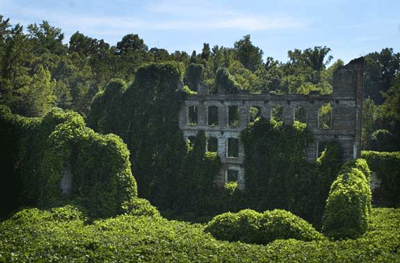When I traveled a lot in the southeast, particularly in Georgia, I saw miles and miles of landscape along the highways that was covered with a vine, which I learned from the locals was called kudzu. People, when I say covered, I don’t mean a vine meandering up a telephone pole or a fence. I mean trees, houses, buildings, flagpoles, fences, gardens, acres and acres, sometimes miles of land covered with the stuff. This plant obviously revels in southern heat and humid environments.
Kudzu isn’t native here; it’s native to the far east was introduced into the US during a Japanese exhibition in Philadelphia in the very early 20th century. An astute scientist noted that the plant grew so quickly (and because it was not native to us), it could quickly become what’s considered an invasive species. Clearly, that’s become the case. The southeast U.S. is covered in the stuff.
I’ve never really noticed kudzu growing in New Orleans. At least, not until recently. We’ve planted two trees in front of our house in Central City; both have sadly died after they reached about eight years old, we think because their root system is blocked by a sewer pipe. Our last casualty was about five months ago, and we sure do miss that shade tree, even though it wasn’t very large. We decided to keep the space vacant until the spring growing season, and try again. The soil was vacant, until someone chopped down two or three trees across the street from our house (presumably to renovate a falling-down apartment house and to create a paved parking area). We think that the trucks that hauled away the debris were contaminated or something, and a seed found its way into our “tree space.” A small vine started growing there. And growing. And growing.
It’s kudzu. I looked it up. It’s been said that the vine propagates so fast that you can almost see it growing, and I can attest to that. We park our car in front of the house, and in the mornings, I swear the tendrils of the vine are trying to wrap around our car tires. It’s really freaky, scary almost (makes me think about that Stephen King short story “Weeds,” later made into one of the episodes in the movie Creepshow, where the hick farmer gets overtaken by an alien plant that covers everything).
It really is that weird.
But then I started thinking that the stuff should be good for something. Too bad we can’t eat it. But then I did some research and found out that not only can parts of the plant be cooked and eaten, baskets can be made of it, the flowers can be made into tea and jelly, and you can even eat some of the roots.
So there’s a good use for everything—even the much-aligned kudzu.
It just has to be kept under control, right?
This exposure to kudzu made me think that if something grows fast enough, and might be considered invasive by some, it may serve a good purpose for others. I’m going to start thinking about music like that: if we plant enough seeds, or scatter those ideas innocently enough, sooner or later—if the environment is welcoming and conducive—interest in local music and musicians will grow like a weed.
What’s it going to take to create that fertile environment?
What do we, as music advocates, need to do to stimulate that welcoming environment? I think the answer lies in music education. We should be teaching our kids about music as we’re reading to them. It’s another form of literacy that has far-reaching ramifications on not only the type of lives they will lead but how they will relate to the culture in which they are born.
There’s a film in the upcoming New Orleans Film Festival that focuses on New Orleans marching bands called The Whole Gritty City that sort of demonstrates the impact of providing a musical environment for kids. Its world premiere is at the Film Fest. I encourage you to see it, as well as Bayou Maharajah, the fine film on the enigmatic James Booker.





